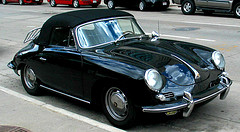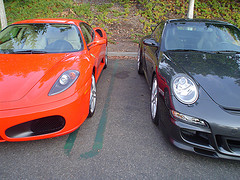Ferdinand Porsche was an automobile engineer with more than a thousand patents to his name, and played a vital role in the development of airplanes and the construction of tanks for the Wehrmacht as well. In the 1920s, he was chosen chief engineer at Mercedes-Benz in Stuttgart and later set up his own engineering workshop. Among other things, there he designed the Volkswagen. He acted as Chief of Operations at the plant where the Volkswagen was made, Wolfsburg, and at the end of the war he was jailed by the Allies.

flickr.com/csessums
He was released a few years after and immediately went to work building his first car with his son, Ferry Porsche. This car was named the Porsche 356, after Ferry, and was a sports car with styling similar to that of the Volkswagen. It had, in fact, the same four-cylinder boxer engine, and wore it rear-mounted, just as the VW did. This meant that it was far from being a great sports car, boasting a mere 40 bhp and a maximum speed of 87 mph (140 km/h). Read more . . .


 In others words, nice attempt; call us again when you have a winner.
In others words, nice attempt; call us again when you have a winner. The P1800 Volvo he drove, was, at least at first, a British car. It was assembled by Jensen, the renowned English sports car maker, after Karmann Ghia lost out on the bidding to build the car. And in one of the most productive marketing moves in the car industry, Volvo decided to capitalize on the British connection by supplying vehicles for the British TV show, “The Saint,” which starred Roger Moore as the slightly shady, free-lance, womanizing, good guy.
The P1800 Volvo he drove, was, at least at first, a British car. It was assembled by Jensen, the renowned English sports car maker, after Karmann Ghia lost out on the bidding to build the car. And in one of the most productive marketing moves in the car industry, Volvo decided to capitalize on the British connection by supplying vehicles for the British TV show, “The Saint,” which starred Roger Moore as the slightly shady, free-lance, womanizing, good guy.  What is now the most famous car the world has ever known suffered so many false starts and survived so much hardship, that it is difficult to imagine a harder road to victory. Yet, somehow, the
What is now the most famous car the world has ever known suffered so many false starts and survived so much hardship, that it is difficult to imagine a harder road to victory. Yet, somehow, the